Jute, Bush Okra
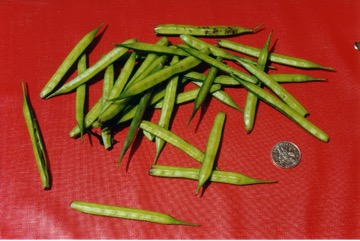
A tropical plant. It is mostly coastal, below 250 m altitude. Temperatures of 22°-35°C are suitable. It can stand both drought (2-3 weeks) and water-logging, except when young. A well drained soil is best. They require humus-rich soils. A pH of 5.5-7.0 is best, but they can grow in soils with pH up to 8.5. They also need adequate moisture for good leaf production. A rainfall of 1,000 mm is suitable. A high relative humidity (80-90%) is best. It produces seeds when day lengths are short. In Yunnan.
Also known as:
Ahu hara, Amolate, An-kin-kiri, An-kirin-kirin, Atigo, Atigo-agywa, Alilot, Awachuwaey, Banpat, Bir narcha, Bogi, Bulukutu, Chench koha, Chichuria, Chilenzi, Daisee, Delele, Demain, Derere, Desipat, Dongo dongo, Enmomi, Ewedu, Eyo, Fetri, Filipino spinach, Fotokani, Fouam, Foukou, Gon-shaw, Grenguere, Guse, Gusha, Gwisha, Hololoqota, Idelele, Igogola, Jew's mallow, Jute mallow, Kaat thoothee, Kapilamoto, Kepotugunta, Kibwando, Kilankozolo, Krachaw, Krenkre, Krinkrin, Kudera, Kudra, Laliaq, Larita, Ligusha, Long fruited Jute, Lusaka-saka, Lusakalusaka, Malafiya, Mangaraw, Melokhia, Mentchelfale, Mithapat, Mlenda mgunda, Morapat, Moroheia, Msakasaka, Muhliye, Mulakhiyah, Mulembo, Mulugaya, Muomi pinpesi, Murere, N genge, N gengle, N'sore, Nainnouwi, Nalta jute, Nkuruma, Nyenje, Othigu-kal, Otigo diri, Oyo, Parinta, Pasau, Pata, Pat shak, Pee-la-ka, Philippine okra, Pilaw-apo, Pilaw-chun, Pilaw-kha, Pilaw-thon-lon-byut, Po krachao, Rau day, Saluyut, Sanpat, Sigli, Singli, Sobe, Sobo, Sore, Soren, Sorre, Spanish okra, Tifaanti, Tifanhanti, Tipanoussante, Tita pat, Tossa jute, Tossa paat, Turgunnuwa, Unsore, Vaizahrui, Valakotha keerai, West African sorrel, Yangui, Yoyo, Yute
Synonyms
- Corchorus catharticus Blanco
- Corchorus decemangularis Roxb. ex G.Don
- Corchorus longicarpus G.Don
- Corchorus malchairii De Wild.
- Corchorus olitorius var. australiensis Domin
- Corchorus olitorius f. grandifolius De Wild.
- Corchorus olitorius var. incisifolius Asch. & Schweinf.
- Corchorus quinquelocularis Moench
Edible Portion
- Leaves, Seeds, Vegetable, Fruit
Where does Jute grow?
Found in: Africa, Angola, Arabia, Asia, Australia, Bangladesh, Benin, Botswana, Burkina Faso, Burundi, Cambodia, Cameroon, Cape Verde, Caribbean, Central Africa, Central African Republic, CAR, Chad, China, Congo DR, Côte d'Ivoire, Cuba, Djibouti, East Africa, East Timor, Egypt, Equatorial-Guinea, Eritrea, Eswatini, Ethiopia, Fiji, France, Gabon, Gambia, Ghana, Guinea, Guinée, Guinea-Bissau, Haiti, Himalayas, India, Indochina, Indonesia, Israel, Ivory Coast, Japan, Kenya, Laos, Liberia, Madagascar, Malawi, Malaysia, Mali, Mauritania, Mauritius, Mozambique, Myanmar, Namibia, Nepal, Niger, Nigeria, North Africa, Northeastern India, Pacific, Pakistan, Papua New Guinea, PNG, Philippines, Qatar, Reunion, Rwanda, Sao Tome and Principe, Saudi Arabia, SE Asia, Senegal, Sierra Leone, Solomon Islands, Somalia, South Africa, Southern Africa, South America, South Sudan, Sri Lanka, Sudan, Swaziland, Syria, Taiwan, Tanzania, Thailand, Timor-Leste, Togo, Turkey, Uganda, United Arab Emirates, UAE, Uganda, United States, Vietnam, West Africa, Zambia, Zimbabwe
Notes: There are about 100 Corchorus species. They are also put in the family Tiliaceae.
Status: It is a commercially cultivated vegetable. An important vegetable in arid areas. It may not be used a lot in Papua New Guinea. It is a part of the national dish of Egypt. Leaves are sold in local markets.
Growing Jute, Bush Okra
Cultivation: Plants grow from seed, and they can be transplanted. Seeds are often broadcast into fine seed beds at the beginning of the wet season. Mixing the small seeds with sand makes it easier to sow them evenly. Often seeds are slow to start growing. This can be overcome by soaking them in hot water. A spacing of 20-30 cm between plants is suitable. For vigorous varieties this could be increases to 45-50 cm. Seeds are saved from pods for re-sowing.
Edible Uses: The young leaves and stem tops are eaten cooked. (They are slimy unless fried.) They are also used to make a thick soup. Leaves can be sun dried, pounded to flour, then stored for a significant time.
Production: First leaves can be harvested after 5-6 weeks. Tips about 20-30 cm long are picked. Production of edible green tips, is not large. 7-8 kg of leaf tips can be harvested from 3-8 pickings over 3-4 months. Seeds can be collected after 13-15 weeks. If seeds of a particular variety are desired, it is necessary to grow these plants 16 m away from other plants, to avoid cross pollination. Seeds can be stored for 8-12 months in well sealed jars.
Nutrition Info
per 100g edible portion| Edible Part | Energy (kcal) | Protein (g) | Iron (mg) | Vitamin A (ug) | Vitamin c (mg) | Zinc (mg) | % Water |
|---|---|---|---|---|---|---|---|
| Leaves raw | 58 | 4.5 | 7.2 | 6410 | 80 | - | 80.4 |
| Leaves cooked | 37 | 3.4 | 3.1 | 156 | 33 | 0.8 | 87.2 |
Jute, Bush Okra Photos

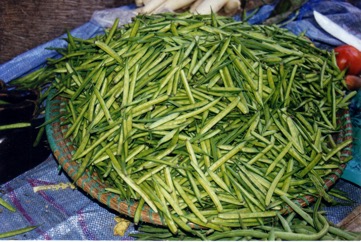
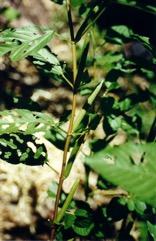
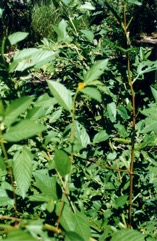
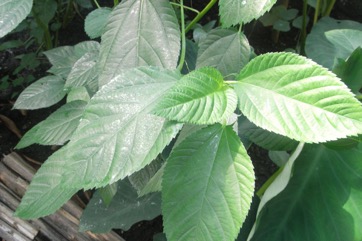
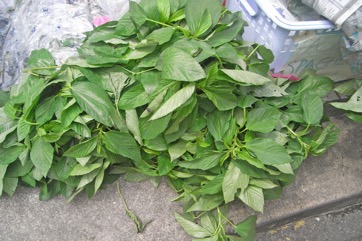
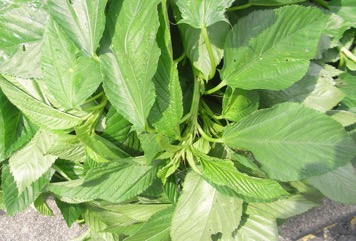
References
Abbiw, D.K., 1990, Useful Plants of Ghana. West African uses of wild and cultivated plants. Intermediate Technology Publications and the Royal Botanic Gardens, Kew. p 42
Achigan-Dako, E, et al (Eds), 2009, Catalogue of Traditional Vegetables in Benin. International Foundation for Science.
Addis, G., Asfaw, Z & Woldu, Z., 2013, Ethnobotany of Wild and Semi-wild Edible Plants of Konso Ethnic Community, South Ethiopia. Ethnobotany Research and Applications. 11:121-141
Addis, G., et al, 2013, The Role of Wild and Semi-wild Edible Plants in Household Food Sovereignty in Hamer and Konso Communities, South Ethiopia. Ethnobotany Research & Applications. 11:251-271
Altschul, S.V.R., 1973, Drugs and Foods from Little-known Plants. Notes in Harvard University Herbaria. Harvard Univ. Press. Massachusetts. no. 2707
Ambasta, S.P. (Ed.), 2000, The Useful Plants of India. CSIR India. p 140
Andabati, B., & Muyonga, J., 2014, Phenolic content and antioxidant activity of selected Ugandian traditional medicinal foods. African Journal of Food Science. 8(8), pp 427-434
Ara, R. I. T., 2015, Leafy Vegetables in Bangladesh. Photon eBooks. p 64
Asfaw, Z., Conservation and use of traditional vegetables in Ethiopia. FAO
Asfaw, Z. and Tadesse, M., 2001, Prospects for Sustainable Use and Development of Wild Food Plants in Ethiopia. Economic Botany, Vol. 55, No. 1, pp. 47-62
Awas, T., 1997, A Study on the Ecology and Ethnobotany of Non-cultivated Food Plants and Wild Relatives of Cultivated crops in Gambella Region, Southwestern Ethiopia. Addis Ababa University. p 69
Balemie, K., & Kebebew, F., 2006, Ethnobotanical study of wild edible plants in Derashe and Kucha Districts, South Ethiopia. Journal of Ethnobiology and Ethnomedicine. p 4
Bandyopadhyay, S. et al, 2009, Wild edible plants of Koch Bihar district, West Bengal. Natural Products Radiance 8(1) 64-72
Belem, M., et al, 2017, Strategy of Conservation and Protection of Wild Edible Plants Diversity in Burkina Faso. ANADOLU 27 (2) 2017, 82- 90
Berihun, T. & Molla, E., 2017, Study on the Diversity and Use of Wild Edible Plants in Bullen District Northwest Ethiopia. Hindawi Journal of Botany. Article ID 8383468
Bernholt, H. et al, 2009, Plant species richness and diversity in urban and peri-urban gardens of Niamey, Niger. Agroforestry Systems 77:159-179
Bodner, C. C. and Gereau, R. E., 1988, A Contribution to Bontoc Ethnobotany. Economic Botany, 43(2): 307-369
Bonou, A., et al, 2013, Valeur economique des Produits Forestiers Non Ligneux (PFNL) au Benin. Editions Universitaires Europeennes p 89
Brown, W.H., 1920, Wild Food Plants of the Philippines. Bureau of Forestry Bulletin No. 21 Manila. p 110
Burkill, H. M., 1985, The useful plants of west tropical Africa, Vol. 1. Kew.
Burkill, I.H., 1966, A Dictionary of the Economic Products of the Malay Peninsula. Ministry of Agriculture and Cooperatives, Kuala Lumpur, Malaysia. Vol 1 (A-H) p 668
Busson, 1965,
Chowdhury, M. & Mukherjee, R., 2012, Wild Edible Plants Consumed by Local Communities of Maldah of West Bengal, India. Indian J.Sci.Res.3(2) : 163-170
Cobley, L.S. (rev. Steele, W.M.) 2nd Ed., 1976, An Introduction to the Botany of Tropical Crops. Longmans. p 146, 269
Codjia, J. T. C., et al, 2003, Diversity and local valorisation of vegetal edible products in Benin. Cahiers Agricultures 12:1-12
Dansi, A., et al, 2008, Traditional leafy vegetables and their use in the Benin Republic. Genet Resour Crop Evol (2008) 55:1239–1256
Dansi, A., et al, 2012, Diversity of the Neglected and Underutilized Crop Species of Importance in Benin. The Scientific World Journal. Volume 2012, Article ID 932947, 19 pages
Dey, A. & Mukhererjee, A., 2015, Living and Survival Amidst Hunger: Wild Edible Botanicals as a Prime Forest Productivity in the Rural Purulia District, West Bengal, India from Colonial to Present. Research Journal of Forestry 9(3): 71-86
Dobriyal, M. J. R. & Dobriyal, R., 2014, Non Wood Forest Produce an Option for Ethnic Food and Nutritional Security in India. Int. J. of Usuf. Mngt. 15(1):17-37
Duguma, H. T., 2020, Wild Edible Plant Nutritional Contribution and Consumer Perception in Ethiopia. Hindawi International Journal of Food Science Volume 2020, Article ID 2958623, 16 pages
Ekman Herbarium records Haiti
Epenhuijsen C.W. van., 1974, Growing Native vegetables in Nigeria. FAO Rome, p 55
Ertug, F, Yenen Bitkiler. Resimli Türkiye Florası -I- Flora of Turkey - Ethnobotany supplement
Ethiopia: Famine Food Field Guide. http://www.africa.upenn.edu/faminefood/category1.htm
Exell, A.W. et al, (Ed), 1963, Flora Zambesiaca Vol 2 Part 1 Crown Agents, London. p 82
Facciola, S., 1998, Cornucopia 2: a Source Book of Edible Plants. Kampong Publications, p 241
FAO, 1988, Traditional Food Plants, FAO Food and Nutrition Paper 42. FAO Rome p 218
Flyman, M. V. & Afolayan, A. J., 2006, A Survey of plants used as wild vegetables in four districts of Botswana. Ecology of Food and Nutrition, 45:405-415
Fondio, L. & Grubben, G.J.H., 2004. Corchorus olitorius L. [Internet] Record from Protabase. Grubben, G.J.H. & Denton, O.A. (Editors). PROTA (Plant Resources of Tropical Africa), Wageningen, Netherlands. < http://database.prota.org/search.htm>. Accessed 15 October 2009.
Food Composition Tables for use in East Asia FAO http://www.fao.org/infoods/directory No. 565
Fowler, D. G., 2007, Zambian Plants: Their Vernacular Names and Uses. Kew. p 44
Fox, F. W. & Young, M. E. N., 1982, Food from the Veld. Delta Books. p 350
French, B.R., 1986, Food Plants of Papua New Guinea, A Compendium. Asia Pacific Science Foundation p 334
French, B.R., 2010, Food Plants of Solomon Islands. A Compendium. Food Plants International Inc. p 313
Gallagher, D. E., 2010, Farming beyond the escarpment: Society, Environment, and Mobility in Precolonial Southeastern Burkina Faso. PhD University of Michigan.
Goode, P., 1989, Edible Plants of Uganda. FAO p 30
Goode, P., 1989, Edible Plants of Uganda. FAO p 36
Goode, P., 1989, Edible Plants of Uganda. FAO p 39
Goode, P., 1989, Edible Plants of Uganda. FAO p 41
Grivetti, L. E., 1980, Agricultural development: present and potential role of edible wild plants. Part 2: Sub-Saharan Africa, Report to the Department of State Agency for International Development. p 49
Grubben, G. J. H. and Denton, O. A. (eds), 2004, Plant Resources of Tropical Africa 2. Vegetables. PROTA, Wageningen, Netherlands. p 217
Hanawa, Y., 2013, Wild edible plants used by Guiziga people of far north region of Cameroon. Int. J. Med. Arom. Plants. Vol 3 (2) : 136-143
Harkonen, M. & Vainio-Mattila, K., 1998, Some examples of Natural Products in the Eastern Arc Mountains. Journal of East African Natural History 87:265-278
Harris, F. M. A. and Salisu Mohammed, 2003, Relying on nature: Wild Foods in Northern Nigeria. AMBIO Vol. 32 No. 1, p 27
Hedrick, U.P., 1919, (Ed.), Sturtevant's edible plants of the world. p 215
Hibbert, M., 2002, The Aussie Plant Finder 2002, Florilegium. p 72
Hussey, B.M.J., Keighery, G.J., Cousens, R.D., Dodd, J., Lloyd, S.G., 1997, Western Weeds. A guide to the weeds of Western Australia. Plant Protection Society of Western Australia. p 226
Ibrahim, H. A., et al, 2012, Ethnobotanical Survey of the Wild Edible Food Plants Consumption among Local Communities in Kano State, North-Western, Nigeria, International Journal of Science and Technology. Vol. 2. No. 10 p 716
Jacquat, C., 1990, Plants from the Markets of Thailand. D.K. Book House p 69
Jadhav, R., et al, 2015, Forest Foods of Northern Western Ghats: Mode of Consumption, Nutrition and Availability. Asian Agri-History Vol. 19, No. 4: 293-317
Jardin, C., 1970, List of Foods Used In Africa, FAO Nutrition Information Document Series No 2.p 69
Johns, T., Mhoro, E. B. and Sanaya, P., 1996, Food Plants and Masticants of the Batemi of Ngorongoro District, Tanzania. Economic Botany, Vol. 50, No. 1, pp. 115-121
Karthi, Sathya, & Salome, 2014, Uncultivated Edible Greens from Small Millet Farms Tamil Nadu India. IDRC
Kays, S. J., and Dias, J. C. S., 1995, Common Names of Commercially Cultivated Vegetables of the World in 15 languages. Economic Botany, Vol. 49, No. 2, pp. 115-152
Kidane, B., et al, 2014, Wild and semi-wild leafy vegetables used by the Maale and Ari ethnic communities in southern Ethiopia. Genetic Resour Crop Evol. Springer. p 8
Kiple, K.F. & Ornelas, K.C., (eds), 2000, The Cambridge World History of Food. CUP p 1793
Latham, P., 2004, Useful Plants of Bas-Congo province. Salvation Army & DFID p 93
Lazarides, M. & Hince, B., 1993, Handbook of Economic Plants of Australia, CSIRO. p 64
Lugod, G.C. and de Padua L.S., 1979, Wild Food Plants in the Philippines. Vol. 1. Univ. of Philippines Los Banos. p 73
Lulekal, E., et al, 2011, Wild edible plants in Ethiopia: a review on their potential to combat food insecurity. Afrika Focus - Vol. 24, No 2. pp 71-121
Lyimo, M., et al, 2003, Identification and nutrient composition of indigenous vegetables of Tanzania. Plant Foods for Human Nutrition. 58: 85-92
Malaisse, F., 1997, Se nourrir en floret claire africaine. Approche ecologique et nutritionnelle. CTA., p 59
Marandi, R. R. & Britto, S. J., 2015, Medicinal Properties of Edible Weeds of Crop Fields and Wild plants Eaten by Oraon Tribals of Latehar District, Jharkhand. International Journal of Life Science and Pharma Research. Vo. 5. (2) April 2015
Maroyi, A., 2013, Use of weeds as traditional vegetables in Shurugwi District, Zimbabwe. Journal of Ethnobiology and Ethnomedicine 9:60
Martin, F.W. & Ruberte, R.M., 1979, Edible Leaves of the Tropics. Antillian College Press, Mayaguez, Puerto Rico. p 39, 221
Masters, T., 2021, Traditional food plants of the upper Aswa River catchment of northern Uganda—a cultural crossroads. Journal of Ethnobiology and Ethnomedicine (2021) 17:24
Maundu, P. et al, 1999, Traditional Food Plants of Kenya. National Museum of Kenya. 288p
Medhi, P. & Borthakur, S. K., 2012, Phytoresources from North Cachur Hills of Assam -3: Edible plants sold at Hflong market. Indian Journal or Natural Products and Resources. 3(1) pp 84-109
Mertz, O., Lykke, A. M., and Reenberg, A., 2001, Importance and Seasonality of Vegetable Consumption and Marketing in Burkina Faso. Economic Botany, 55(2):276-289
Miguel, E., et al, 1989, A checklist of the cultivated plants of Cuba. Kulturpflanze 37. 1989, 211-357
Msuya, T. S., et al, 2010, Availability, Preference and Consumption of Indigenous Foods in the Eastern Arc Mountains, Tanzania, Ecology of Food and Nutrition, 49:3, 208-227
Neudeck, L. et al, 2012, The Contribution of Edible Wild Plants to Food Security, Dietary Diversity and Income of Households in Shorobe Village, Northern Botswana. Ethnobotany Research & Applications 10:449-462
Norton, J., et al, 2009, An Illustrated Checklist of the Flora of Qatar. UNESCO Office in Doha.
Nyadanu, D., et al, 2015, Agro-biodiversity and challenges of on-farm conservation: the case of plant genetic resources of neglected and underutilized crop species in Ghana. Genet. Resourc. Crop Evol. 62(7):
Okigbo, B.N., Vegetables in Tropical Africa, in Opena, R.T. & Kyomo, M.L., 1990, Vegetable Research and development in SADCC countries. Asian Vegetable Research and development Centre. Taiwan. p 45
Onuminya, T. O., et al, 2017, Comparative proximate and Phytochemical Analysis of leafy vegetables in Lagos State. Nig. J. Pure and Applied Sci. Vol. 30 Issue 3: p 3097f
Oomen, H.A.P.C., & Grubben, G.J.H., 1978, Tropical Leaf Vegetables in Human Nutrition, Communication 69, Department of Agricultural research, RTI Amsterdam, p 32, 36, 66, 79
Paczkowska, G . & Chapman, A.R., 2000, The Western Australian Flora. A Descriptive Catalogue. Western Australian Herbarium. p 561
Peters, C. R., O'Brien, E. M., and Drummond, R.B., 1992, Edible Wild plants of Sub-saharan Africa. Kew. p 190
Pham-Hoang Ho, 1999, An Illustrated Flora of Vietnam. Nha Xuat Ban Tre. p 480
Phon, P., 2000, Plants used in Cambodia. © Pauline Dy Phon, Phnom Penh, Cambodia. p 172
Pickering, H., & Roe, E., 2009, Wild Flowers of the Victoria Falls Area. Helen Pickering, London. p 109
Plants for a Future database, The Field, Penpol, Lostwithiel, Cornwall, PL22 0NG, UK. http://www.scs.leeds.ac.uk/pfaf/
Plants of Haiti Smithsonian Institute http://botany.si.edu/antilles/West Indies
Plowes, N. J. & Taylor, F. W., 1997, The Processing of Indigenous Fruits and other Wildfoods of Southern Africa. in Smartt, L. & Haq. (Eds) Domestication, Production and Utilization of New Crops. ICUC p 189
Purseglove, J.W., 1968, Tropical Crops Dicotyledons, Longmans. p 614
Rashid, H. E., 1977, Geography of Bangladesh. Westview. p 310, 281
Rubaihayo, E. B., Conservation and use of traditional vegetables in Uganda. Bioversity International.
Ruiters-Welcome, A. K., 2019, Food plants of southern Africa. Ph.D. thesis. Univ. of Johannesburg p 75
Sang, D. T., & Mizoue, K. O. N., 2012, Use of Edible Forest Plants among Indigenous Ethnic Minorities in Cat Tien Biosphere Reserve, Vietnam. Asian Journal of Biodiversity Vol. 3 (1), p 23-49
Segnon, A. C. & Achigan-Dako, E. G., 2014, Comparative analysis of diversity and utilization of edible plants in arid and semi-arid areas in Benin. Journal of Ethnobiology and Ethnomedicine 2014, 10:80
Setiya, A. V., et al, 2016, Exploration and documentation of some wild edible plants used by the aboriginals from Gadchiroli District (M.S.) India. International Advanced Research Journal in Science, Engineering and Technology. 3(7)
Sharma, B.D., & Lakshminarasimhan, P., 1986, Ethnobotanical Studies on the Tribals of Nasik District (Maharashtra). J. Econ. Tax. Bot. Vol. 8 No. 2 pp 439-446
SHORTT,
Singh, D.P., 1979, Jute, in Simmonds, N.W., (ed), Crop Plant Evolution. Longmans. London. p 290
Sinha, R. & Lakra, V., 2007, Edible weeds of tribals in Jharkhand, Orissa and West Bengal. Indian Journal of Traditional Knowledge 6(1) January 2007 pp 217-222
Smith, A.C., 1981, Flora Vitiensis Nova, Lawaii, Kuai, Hawaii, Volume 2 p 367
Smith, K., 1998. Growing Uncommon Fruits and Vegetables. New Holland. p 7
Sp. pl. 1:529. 1753
Staples, G.W. and Herbst, D.R., 2005, A tropical Garden Flora. Bishop Museum Press, Honolulu, Hawaii. p 548 (Drawing)
Tebkew, M. et al, 2014, Underutilized wild edible plants in the Chilga District, northwestern Ethiopia: focus on wild woody plants. Agriculture & Food Security 3:12
Tebkew, M., et al, 2018, Uses of wild edible plants in Quara district, northwest Ethiopia: implication for forest management. Agriculture and Food Security (2018) 7:12
Tindall, H.D., & Williams, J.T., 1977, Tropical Vegetables and their Genetic Resources, International Board for Plant Genetic Resources, Rome, p 102
Tindall, H.D., 1983, Vegetables in the Tropics, Macmillan p 392
USDA, ARS, National Genetic Resources Program. Germplasm Resources Information Network - (GRIN). [Online Database] National Germplasm Resources Laboratory, Beltsville, Maryland. Available: www.ars-grin.gov/cgi-bin/npgs/html/econ.pl (10 April 2000)
Vainio-Mattila, K., 2000, Wild vegetables used by the Sambaa in the Usumbara Mountains, NE Tanzania. Ann. Bot. Fennici 37:57-67
van Wyk, B., 2005, Food Plants of the World. An illustrated guide. Timber press. p 151
Vernon, R., 1983, Field Guide to Important Arable Weeds of Zambia. Dept of Agriculture, Chilanga, Zambia. p 48
WATT,
Wehmeyer, A. S, 1986, Edible Wild Plants of Southern Africa. Data on the Nutrient Contents of over 300 species
Weinberger, K., Msuya J., 2004, Indigenous Vegetables in Tanzania. Significance and Prospects. Technical Bulletin No. 31 AVRDC, Taiwan/FAO p 4
Wheeler, J.R.(ed.), 1992, Flora of the Kimberley Region. CALM, Western Australian Herbarium, p 164
Wild edible plants of Himachal Pradesh
Williams, C.N., Chew, W.Y., and Rajartnam, J.A., 1989, Tree and Field Crops of the Wetter Regions of the Tropics. Longman, p 84
Williamson, J., 2005, Useful Plants of Malawi. 3rd. Edition. Mdadzi Book Trust. p 78
World Checklist of Useful Plant Species 2020. Royal Botanic Gardens, Kew
www.zimbabweflora.co.zw 2011
Zon, A.P.M. van der, Grubben, G.J.H., 1976, Les legumes-feuilles spontanes et cultives du Sud-Dahomey, Communication 65, Royal Tropical Institute, Amsterdam, p 52